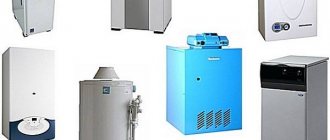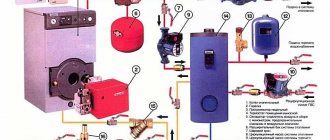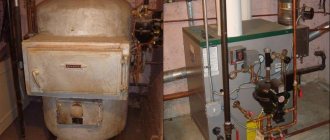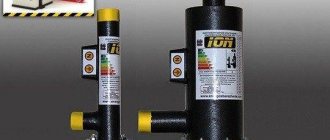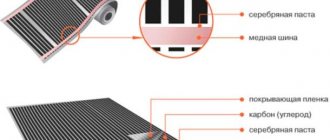Features of installing heat accumulators
All installation work is carried out according to a previously approved project in accordance with the recommendations of the heating equipment manufacturer.
In this case, it is necessary to take into account the features of installation work:
- The surface of the storage tank must be insulated from heat loss without fail.
- Thermometers should be installed on the pipelines through which water circulates (outlet and inlet).
- Battery containers with a volume of over 500 liters in most cases do not fit through the doorway. In such cases, you should use collapsible structures or install several smaller batteries.
- It would not hurt to install a drainage channel at the lowest point of the container. It will come in handy when you have to completely drain the water.
- It is advisable to install mesh filters on the pipelines through which water enters the container. They will prevent large inclusions from getting inside (welding scale, minerals trapped in the system, etc.).
- If there is no air vent valve at the top of the container, it should be installed at the top point of the outlet pipe.
- It is necessary to install a pressure gauge and a safety valve on the line next to the battery.
If you are the owner of a solid fuel boiler and have not yet purchased a heat accumulator, think about it. You will not only extend the life of your heating equipment, but also significantly save on fuel.
Do-it-yourself heat accumulator for a greenhouse
It is almost impossible to place such a heating device in a ready-made greenhouse. Therefore, it is necessary to create it even before building the frame. The sequence of actions here will be as follows:
- A pit about 30 cm deep is dug across the entire area of the greenhouse. In this case, care should be taken to preserve the top layer with humus. Fertile soil will still be useful both in the greenhouse itself and for other garden work;
- Either coarse sand or fine crushed stone is poured into the bottom of the pit. After filling the 10 cm layer, the surface is carefully compacted. The sand cushion will allow the emerging condensate to escape into the lower layers of the soil without causing waterlogging ;
- a system of horizontal air ducts is formed. They should be placed along the beds. sewer pipes with a diameter of 110 mm as a manufacturing material . If necessary, they can be combined into the desired configuration through tees and crosses;
- It is recommended to install fans in the inlet and outlet pipes (taking into account the direction of air flow). For the option with natural circulation, the outlet pipes will have to be made higher than the inlet pipes .
The use of solar thermal energy storage devices in greenhouse farming can significantly reduce the cost of its maintenance. At the same time, the costs of materials are fully recouped by the additional harvest, and there are no costs for specialists at all, since everything can be done with your own hands.
Functionality of heat accumulators
The principle of operation of the equipment is that during operation of the boiler, part of the heat is used to heat the coolant from an additional tank. The connected tank has good thermal insulation and perfectly retains the resulting heat. After the boiler is turned off, the water in the heating system cools down, and the control devices turn on the pump that supplies hot water from the storage tank.
These cycles continue as long as the water temperature in the auxiliary tank remains high enough. The total duration of operation of the system without turning on the boiler depends on the volume of the additional capacity. In practice, it allows you to heat rooms from several hours to 2 days.
The heat accumulator performs the following functions:
- It accumulates heat coming from the system boiler and releases it over time to heat the rooms of the room.
- Prevents the possibility of boiler overheating by removing excess heat from the exchanger.
- Allows you to easily combine different heating devices (electric, gas, solid fuel) into a common system.
- Helps improve the performance of heating equipment, reducing fuel consumption and improving efficiency.
- In systems with solid fuel boilers, it eliminates constant monitoring of the condition of heating equipment. By heating the coolant in an additional container, homeowners can forget about the need to constantly load fuel into the boiler.
- It is a source of hot water for domestic needs.
Heating system diagram
How profitable a heating system with a heat accumulator is can be seen using this example.
Let's assume that a 10 kW boiler is installed in the heating system. Every 3 hours it is necessary to load firewood. This does not fit into the plans of the homeowners. To lengthen the breaks between loads, it is necessary to use a larger boiler. But in this case, the coolant may boil, since the system will not have time to remove all the generated heat.
Connecting a heat accumulator with a capacity of about 200 liters easily solves the problem. The equipment allows you to accumulate 110 kW of energy provided that the boiler is fully and frequently loaded. Subsequently, the accumulated heat will maintain a comfortable room temperature for about 10 hours. There is no need to load the boiler with fuel all this time.
Possible connection diagrams
Pressure, temperature conditions and coolant requirements are identical for boilers and circuits. The limiter for adjustment on devices is only the amount of coolant passing through.
Almost repeats the scheme presented above. The only difference is that the adjustment depends on how the temperature of the coolant changes. Therefore, the circuit includes three-way valves. This scheme allows you to use the accumulated potential to the fullest.
In this scheme, the coolant circulates through a small circuit. It is effective where there is excess pressure in the tank itself or in devices, as well as when using different coolants in the circuits and boiler.
Used for conditions similar to scheme No. 3, but an external heat exchanger is used.
Designed to provide running heated water. It has a built-in heat exchanger, characterized by a spiral shape. Uniform consumption without peak loads is calculated.
A built-in tank is used. Used during peak loads, i.e. uneven water consumption. Having used the accumulated supply of hot water, subsequent heating, which begins after filling the tank, takes a lot of time.
A bivalent connection with an additional heat source, which is the solar collector, which carries the main load. The boiler is turned on as needed if there is a lack of basic energy for heating.
Multivalent scheme with three heat sources: a boiler, which plays an auxiliary role, a solar collector and a low-temperature source, characterized by high stability, independence of season and time of day - a geothermal heat pump.
The diagrams are clearly simplified.
In reality they are much more complex:
- different heating circuits are used;
- heating occurs from different power sources with different temperatures.
Below is an example diagram:
- solid fuel boiler;
- electric (auxiliary), switched on during the discounted tariff (if necessary);
- block in the circuit of a high-temperature boiler;
- heliostation (the main source in sunny weather);
- heat generator that receives heat from all circuits;
- high-temperature circuit with the ability to adjust modes;
- low-temperature circuit, with provision for regulation of coolant heating;
- a flowing hot water supply circuit with a mixing unit to regulate the heating of domestic water. In addition to the listed devices, heating elements are often used to maintain the desired temperature, without unscheduled switching on of a solid fuel boiler.
The heating element of the heat accumulator has its own thermostatic system:
What is a heat accumulator buffer tank and its purpose.
The purpose of a heat accumulator (TA) will be easier to describe using several example problems.
Task one. The heating system is based on a solid fuel boiler. There is no way to constantly monitor the temperature of the coolant in the supply and add firewood in a timely manner, as a result of which the supply temperature either exceeds what we need or drops below normal. How to ensure that the required coolant temperature is maintained?
Task two. The house is heated by an electric boiler. Electricity supply is two-tariff. How to reduce energy costs by reducing energy consumption during the day and increasing it at night?
Task three. There is a heating system in which heat is generated by heat generators running on various types of fuel and energy - e.g. gas, electricity, solar energy (solar collectors), earth energy (heat pump). How to ensure their efficient operation without loss of generated heat when there is no need for it, while at the same time providing the house with heat during periods of peak energy consumption?
Without going too much into the theory of heat engineering, for all problems a solution suggests itself in the form of installing a buffer tank in the system, which would serve as a reservoir for the coolant and in which its temperature would be maintained at a given level. The heat accumulator is precisely such a buffer capacity. To solve these problems, the heat accumulator is usually connected “into the gap” of the system to form the boiler and heating circuits. A schematic diagram for connecting a heat accumulator to a heating system is shown in the figure below.
Rice. Schematic diagram of switching on a buffer tank (heat accumulator)
Various ways to connect a buffer tank to a heating system can be found in the article “Heat accumulator connection diagrams”.
Currently, heat accumulators are most often used in heating systems with solid fuel boilers. In these systems, the use of a heat accumulator makes it possible to load fuel less frequently and provide a comfortable supply of heat regardless of fluctuations in the coolant temperature at the boiler outlet. Often, buffer tanks are installed with electric boilers to save money due to a reduced night tariff and in combined systems with the simultaneous use of solid fuel and electric boilers. A heat accumulator (TA) can be useful in systems with gas boilers, especially when the minimum thermal power of the boiler exceeds the thermal load of the facility. Due to longer periods of “loading” the heat exchanger (heating the coolant), it is possible to avoid “clocking” the boiler.
In addition to being used as a buffer tank, the TA serves as a hydraulic separator. This property of a heat accumulator is especially in demand in systems with heat generators operating on different types of energy (including alternative). As a rule, these heat sources operate on special coolants that do not allow mixing with other types and require a unique temperature and hydraulic regime, often incompatible with the heating circuit modes (radiator, heated floor). For example, the temperature range of a heat pump is typically
5°C, and in the heat distribution circuit the temperature range can be much larger (10-20°C). To separate the circuits, the heat accumulator can be equipped with additional built-in heat exchangers.
What is a heat accumulator
But when operating the unit using solid fuel, you will have to face the problem of heterogeneity in the production of thermal energy.
While the boiler is working, the house is warm or even hot. When the fuel runs out, the house becomes cold. Half of the heat received goes into the atmosphere, and you have to add firewood often. Therefore, we thought about storing excess heat and then slowly releasing it into the heating system. This problem is solved when they begin to operate a solid fuel boiler with a heat accumulator.
In European countries, the use of thermal energy units without a buffer tank is prohibited to prevent carbon monoxide emissions into the atmosphere.
A heat accumulator is a container, most often round cylindrical, filled with water; depending on its purpose, it comes in different modifications.
The production version includes:
- main body, which is made of various steel alloys or stainless steel;
- a layer of insulation made of basalt or mineral wool or polyurethane foam with a thickness of at least 50 mm;
- the outer skin is made of either painted thin sheet metal or a cover made of polymer material;
- pipes for supplying and discharging coolant are cut into the main container;
- in more expensive models, a coil is installed inside to heat water;
- The thermometer and pressure gauge are used to monitor temperature and pressure.
Sometimes a block of electric heaters with sensors is built into the heat accumulator and solar panels are connected - this creates additional comfort when using it.
The prices for these options are high, so craftsmen most often make buffer containers with their own hands.
What is it needed for
The range of applications of the thermal energy accumulator is very wide and is determined according to the modification and equipment used with it.
Its most important purpose:
- accumulate as much heat as possible, and then, when the fuel in the main heat generator runs out, transfer it to the heating system;
- prevent sudden changes in temperature in the system, thereby preventing the appearance of condensation in the boiler.
More modern and expensive ones allow you to create more comfort and more opportunities:
- hot water supply in the house;
- use it instead of an electric boiler if you install electric heaters in it.
Principle of operation
Before first use, it is recommended to study the operating diagram of the boiler and container.
The system works like this:
- The boiler was flooded.
- The heated water enters the heat generator, as if charging it.
- A circulation pump installed behind the tank, through a pipeline built into its upper part, delivers the coolant to the heating pipes.
- Returning, the cooled water enters the lower part of the heat generator.
- Then it goes into the boiler.
- The fuel ran out and the boiler went out.
- The heat generator comes into operation: using a circulation pump, it gradually distributes the stored heat through the pipes and radiators from the upper hot zone.
The second pump is equipped with a room temperature sensor, which can, if necessary, turn it off if the temperature exceeds its set temperature. Then the boiler will only heat the heat accumulator. When the air temperature in the rooms drops, the pump turns on and the water will heat the radiators again.
The use of a thermal energy accumulator allows the owner of a household to satisfy all his needs.
Flaws
Combining a thermal heater with a thermal storage device, of course, has its drawbacks, but over time the buyer will understand that the investment was not wasted.
How to calculate the volume of a heat accumulator
If you wish, you can easily find methods for calculating the volume of a heat accumulator on the Internet, but none of them suited me.
Some “experts” recommend multiplying the maximum power of the existing boiler in kilowatts by some coefficient, and this coefficient on different sites differs by a factor of two or more - from 25 to 50. In my opinion, this is complete nonsense. Simply because the result obtained has nothing to do with your specific home or your wishes of how often you want to heat the boiler.
The normal method takes into account all factors: the climate in your area, the thermal insulation of the house, and your ideas about comfort. In a good way, this calculation will also need to be carried out many times for different temperature conditions, and the maximum volume of the heat accumulator must be selected. And, by the way, the power of the boiler in the correct method is obtained as a result of calculations, and not according to the principle “what it was, that’s how it was installed.” But all this is quite complicated, and is more suitable for boiler houses, rather than for private households.
I did it much simpler. I calculated the heat accumulator for a solid fuel boiler as follows.
- It is necessary to estimate the amount of heat that the house requires per day. This is the most difficult and responsible part of the work. Again, you can go deeper into the calculations (you can find all the necessary techniques in textbooks for construction universities). But, if possible, it is easier and more reliable to carry out a direct measurement - simply by heating the house in cold weather and measuring the amount of fuel used. My house is relatively small - a little less than 100 square meters. m, and quite warm. Therefore, it turned out that when the outside temperature is about 0 degrees, to maintain a comfortable temperature, a solid reserve of 50 kWh is required, for - 10 degrees - 100 kWh, for - 20 degrees - 150 kWh.
- Choosing a boiler is very simple. The most common boilers have a power of about 25 kW and with one maximum load they provide this power for about 3 hours. Therefore, one kindling provides about 75 kWh of heat. For zero temperatures, therefore, even one full load will be too much for me. And for -20 degrees, it will be enough to heat it 2 times a day. I was quite happy with this option.
- Now the actual volume of the heat accumulator. The heat capacity of water is 4.2 kJ per liter per degree. The maximum temperature in the heat accumulator is 95 degrees, the comfortable water temperature in the heating system is 55 degrees. That is, 40 degrees difference. In other words, 1 liter of water in a heat accumulator can accumulate 168 kJ of heat, or 46 Wh. And 1000 liters, respectively - 46 kWh. It follows that in order to retain heat from one full load of the boiler, I need a heat accumulator with a capacity of 1500 liters. This is all with reserve. In fact, a little less is required, but after studying the prices of buffer containers, I decided to ignore this.
This calculation means that in severe frosts I have to heat the boiler twice a day, and in very severe frosts - three times. Moreover, this should be done evenly throughout the day: in the morning and evening or in the morning, at the beginning of the evening and before bed. And when there is no severe frost, I heat the boiler only once - at any time of the day.
Of course, if you install a heat accumulator with an even larger volume, you can make your life even more comfortable. But here you have to face the fact that a large barrel requires a lot of space.
Advantages and disadvantages
A heating system with a heat accumulator, in which the heat source is a solid fuel unit, has a lot of advantages:
- Increasing comfortable conditions in the house, since after the fuel is burned, the heating system continues to heat the house with hot water from the tank. No need to get up in the middle of the night and load a portion of firewood into the firebox.
- The presence of the container protects the boiler water jacket from boiling and destruction. If the electricity is suddenly turned off or the thermostatic heads installed on the radiators turn off the coolant because the desired temperature has been reached, the heat source will heat the water in the tank. During this time, the electricity supply may be restored or the diesel generator will be started.
- The supply of cold water from the return pipeline to the hot cast iron heat exchanger is excluded after the circulation pump is suddenly turned on.
- Heat accumulators can be used as hydraulic separators in a heating system (hydraulic arrows). This makes the operation of all branches of the circuit independent, which provides additional savings in thermal energy.
The higher cost of installing the entire system and the requirements for equipment placement are the only disadvantages of using storage tanks. However, this investment and inconvenience will be followed by minimal operating costs in the long run.
We recommend:
How to make heating in a private house - a detailed guide How to choose an expansion tank for a heating system How to select and connect a membrane expansion tank
Solid fuel heating boiler and heat accumulator
Very often, heat accumulators are used precisely to preserve the heat generated by a heating boiler. This is due to the fact that the boiler does not always emit heat equally during the period of fuel combustion; in order to balance the heating process and make it as even as possible in terms of the temperature regime in the house, heat accumulators or, as they are also called, buffer tanks are used.
Devices for monitoring pressure and temperature in the heating system are installed next to the heat accumulator, and a stable base is equipped for the buffer tank and boiler.
The operation of heat accumulators has its drawbacks: the house takes too long to warm up during the initial startup of the system, high cost, and requires high boiler power.
Pumps that increase pressure - review of 2021 models, recommendations for choosing parameters for the heating system (105 photos)
Heating pressure testing pumps - manual and automatic models for modern heating systems (90 photos and videos)- Repair of the circulation pump - main types of faults, disassembly, repair and assembly of the pump in the heating system (video + photo)
Calculation of heat accumulator capacity
The method by which the calculation is made may vary depending on the application scheme. Here is an approximate calculation scheme:
- Determination of maximum fuel load. For example, the firebox can hold 20 kg of firewood. 1 kg of firewood can release 3.5 kWh of energy. Thus, when burning one stack of firewood, the boiler will produce 20·3.5=70 kWh of heat. The time it takes for a full bookmark to burn can be determined empirically or calculated. If the boiler power is, for example, 25 kW 70:25 = 2.8 hours.
- Coolant temperature in the heating system. If the system is already installed, it is enough to measure the temperature at the inlet and outlet and determine the heat loss.
- Determining the desired download frequency. For example, it is possible to load in the morning and evening, but it is not possible to service the boiler during the day and at night.
Heat accumulator calculation
If, for example, the heat loss of a room per hour is 6.7 kW, then per day it will be 160 kW. In the example under consideration, this amounts to little more than two loads of fuel. As defined above, one load of firewood burns for about 3 hours, releasing 70 kWh of thermal energy.
The need for heating the house is 6.7·3=20.1 kWh, the storage tank reserve will be 70-20.1=49.9, that is, approximately 50 kWh. This energy is enough for a period of 50:6.7 - this is about 7 hours. This means that two full nests and one incomplete one are required per day.
Based on these calculations, having considered several options, we settle on this: at 23:00 a partial load is made, at 6:00 and 18:00 – full. If you draw a graph of the charge level of the heat accumulator, you can see that the maximum charge is 60 kWh at 9 am.
Since 1 kW·h=3600 kJ, the reserve should be 60·3600=216000 kJ of thermal energy. Temperature reserve (difference between the maximum water indicator and the required supply indicator) 95-57 = 38°C. The heat capacity of water is 4.187 kJ. Thus, 216000/(4.187·38)=1350 kg. In this case, the required volume of the heat accumulator will be 1.35 m3.
The considered example gives a general idea of how the capacity of a storage tank is calculated. In each individual case, it is necessary to take into account the characteristics of the heating system and its operating conditions.
Features of installing a heat accumulator
Before installing the equipment, a detailed design must be drawn up. It is necessary to take into account all the requirements of heating equipment manufacturers. When installing a storage tank, the following rules must be observed:
- The surface of the container must have reliable thermal insulation.
- Thermometers should be installed at the inlet and outlet to monitor the water temperature.
- Bulk tanks most often do not fit into the doorway. If it is not possible to bring in the tank before construction is completed, you will have to use a collapsible version or several smaller tanks.
- It is desirable to have a coarse filter on the inlet pipe.
- A safety valve and pressure gauge should be installed next to the tank. The tank itself should also have an air vent valve.
- It must be possible to drain water from the tank.
The use of a heat accumulator in a system with a solid fuel boiler increases the efficiency of the heat generator and its service life, and also allows for more economical fuel consumption. The possibility of adding fuel more rarely makes using the heating boiler more convenient for the consumer. Calculation of the required capacity of the storage tank must take into account the type of boiler, the features of the heating system and its operating conditions.
Despite the simplicity of the device and the obvious benefits of using heat accumulators, this type of equipment is not yet very widespread. In this article we will try to talk about what a heat accumulator is and the benefits that its use in heating systems brings.
Application of heat accumulators
There are several methods for calculating tank volume. Practical experience shows that on average, for every kilowatt of heating equipment power, an additional 25 liters of water are needed. The efficiency of solid fuel boilers, which includes a heating system with a heat accumulator, increases to 84%. By leveling combustion peaks, up to 30% of energy resources are saved.
When using tanks to supply domestic hot water, there are no interruptions during peak hours. At night, when needs are reduced to zero, the coolant in the tank accumulates heat and in the morning again provides all needs in full.
Reliable thermal insulation of the device with polyurethane foam (polyurethane foam) allows you to maintain the temperature. Additionally, it is possible to install heating elements, which helps to quickly “catch up” with the desired temperature in case of emergency.
Heat accumulator in section
Heat storage is recommended in the following cases:
- great need for hot water supply. In a cottage where more than 5 people live and two bathrooms are installed, this is a real way to improve living conditions;
- when using solid fuel boilers. Batteries smooth out the operation of heating equipment during peak hours, remove excess heat, preventing boiling, and also increase the time between refills of solid fuel;
- when using electrical energy at separate tariffs for daytime and nighttime;
- in cases where solar or wind batteries are installed for storing electrical energy;
- when used in the heat supply system of circulation pumps.
This system is perfect for rooms heated with radiators or underfloor heating. Its advantages are that it is able to accumulate energy received from various sources. A combined energy supply system allows you to choose the most optimal option for obtaining heat for a given period of time.
How does a heating system with a heat accumulator work?
A heat accumulator for heating boilers is a part of the heating system designed to increase the time between loading solid fuel into the boiler. It is a reservoir into which there is no air access. It is insulated and has a fairly large volume. There is always water in the heat accumulator for heating, and it circulates throughout the entire circuit. Of course, non-freezing liquid can also be used as a coolant, but still, due to its high cost, it is not used in circuits with TA.
In addition, there is no point in filling a heating system with a heat accumulator with antifreeze, since such tanks are placed in residential premises. And the essence of their use is to ensure that the temperature in the circuit is always stable, and therefore the water in the system is warm. The use of a large heat accumulator for heating in temporary country houses is impractical, and a small reservoir is of little use. This is due to the operating principle of the heat accumulator for the heating system.
- TA is located between the boiler and the heating system. When the boiler heats the coolant, it enters the heat exchanger;
- then the water flows through pipes to the radiators;
- the return flow returns to the TA, and then directly to the boiler.
In order for the TA to perform its main function of storing heat, these flows must be mixed. The difficulty is that high temperatures always rise, and cold tends to fall. It is necessary to create such conditions so that part of the heat sinks to the bottom of the heat accumulator in the heating system and heats the return coolant. If the temperature is equalized throughout the tank, then it is considered fully charged.
After the boiler has burned out everything that was loaded into it, it stops working and the TA comes into play. The circulation continues and it gradually releases its heat through the radiators into the room. All this happens until the next portion of fuel enters the boiler again.
If the heat accumulator for heating is small, then its reserve will last only for a short time, while the heating time of the batteries increases, since the volume of coolant in the circuit has become larger. Disadvantages of using for temporary residences:
- the room warm-up time increases;
- larger volume of the circuit, which makes filling it with antifreeze more expensive;
- higher installation costs.
As you understand, filling the system and draining water every time you come to your dacha is troublesome, to say the least. Considering that the tank alone will be 300 liters, it makes no sense to take such measures for the sake of a few days a week.
Additional circuits are built into the tank - these are metal spiral pipes. The liquid in a spiral does not have direct contact with the coolant in the heat accumulator for heating the house. These could be contours:
- DHW;
- low temperature heating (warm floor).
Thus, even the most primitive single-circuit boiler or even stove can become a universal heater. It will provide the entire house with the necessary heat and hot water at the same time. Accordingly, the heater's performance will be fully used.
In serial models manufactured under production conditions, additional heating sources are built in. These are also spirals, only they are called electric heating elements. There are often several of them and they can work from different sources:
- circuit;
- solar panels.
Such heating is an additional option and is not mandatory; keep this in mind if you decide to make a heat accumulator for heating with your own hands.
Design features of the heat accumulator
The device is a cylindrical container made of stainless steel or black steel. The dimensions of the container depend on its volume, which varies from several hundred to tens of thousands of liters. Due to its large volumes, it is difficult to place such a device in an existing boiler room, so it is often necessary to expand it. There are models with factory thermal insulation and containers without it.
When installing a heat accumulator, you need to take into account that the thickness of the insulation is 10 cm. After it, a leather casing is placed on top of the tank. Inside the container there is a coolant, which, when fuel is burned in the boiler, quickly heats up and retains heat for a long time due to the insulation layer. After the boiler stops operating, the storage tank releases its heat into the room, heating it. For this reason, it will not be necessary to light the boiler as often as before.
According to their design, heat accumulator capacities are:
- with a boiler located inside. This design was created to provide housing with hot water from an autonomous source;
- with one or two heat exchangers;
- empty (without coolant).
Threaded holes are provided to connect the storage device to the boiler and home heating system.
Making a heat accumulator with your own hands
The simplest battery model can be made independently, and you should be guided by the operating principles of a thermos. Due to the walls that do not conduct heat, the liquid will remain hot for a long time. To work you should prepare:
- scotch;
- concrete slab;
- thermal insulation material;
- copper tubes or heating elements.
When choosing a tank, it is necessary to take into account the desired capacity, it should start from 150 liters. You can choose any metal barrel. But if you choose a volume less than that mentioned, then the meaning is lost. The container is prepared, dust and debris are removed from the inside, areas where corrosion has begun to form must be treated accordingly.
Background
It so happened that some time ago I purchased a private house at some distance from civilization. The distance from civilization is determined mainly by the fact that there is no gas there in principle. And the permitted power of the electrical connection does not provide the technical ability to heat the house with electricity. The only real source of heat in winter is the use of solid fuel. In other words, the house was equipped with a stove, which the previous owner heated with wood and coal.
If someone has experience using a stove, then they do not need to explain that this activity requires constant monitoring. Even in not too cold weather, it is impossible to put wood in the stove once and “forget” about it. If you put too much wood in, the house will become hot. And after the fuel burns out, the house will still cool down quickly. Willy-nilly, to maintain a comfortable temperature you need to constantly add firewood little by little. And in severe frosts the oven cannot be left unattended even for 3-4 hours. If you don’t want to wake up in the morning in a cold room, be kind enough to go to the stove at least once a night...
Of course, I had no desire to work as a fireman. And so I immediately began to think about a more convenient heating method. Of course, if it was impossible to use gas or electricity, this method could only be a modern solid fuel heating system, consisting of a solid fuel boiler, a heat accumulator and simple automation for turning the recirculation pump on and off.
Why is a modern boiler better than a conventional stove? It takes up much less space, you can put more fuel in it, it ensures better combustion of this fuel at maximum load, and theoretically with its help you can leave most of the heat in the house rather than release it into the chimney. But unlike a stove, a solid fuel boiler is practically impossible to use without a heat accumulator. I am writing about this in such detail because I know many people who tried to heat their houses with such boilers, connecting them directly to the heating pipes. They didn't do anything good.
What is a heat accumulator or, as it is also called, a buffer tank? In the simplest case, it is simply a large barrel of water, the walls of which have good thermal insulation. The boiler heats the water in this barrel during its two to three hours of operation. And then this hot water circulates through the heating system until it cools down. As it cools down, the boiler needs to be lit again. The simplest heat accumulator can be easily made by any welder. But after some thought, I abandoned this idea and bought a ready-made one. Since I live in Ukraine, I turned to it and have never regretted it: here they make storage tanks professionally and of very high quality.
Depending on the volume of the heat accumulator, the power of the boiler and how much heat the house needs, the boiler does not have to be heated constantly, but once or twice a day, or even once every two or three days.
Calculation of the volume of the boiler buffer tank
The most optimal solution to this task would be to entrust its implementation to heating engineers. Calculating the volume of a heat accumulator for the entire heating system of a private house requires taking into account various factors known only to them. Despite this, you can make preliminary calculations yourself. To do this, in addition to general knowledge of physics and mathematics, you will need a calculator and a blank sheet of paper.
We find the following data
:
- boiler power, kW;
- time of active fuel combustion;
- thermal power of heating the house, kW;
- boiler efficiency;
- temperatures in the supply and return pipes.
Let's look at an example of a preliminary calculation. Heated area - 200 m2. Active burning time of the boiler - 8 hours, coolant temperature during heating - 90° C, in the return circuit - 40° C. The estimated thermal power of the heated rooms is 10 kW. With such initial data, the thermal device will receive 80 kW (10×8) of energy.
We calculate the buffer capacity of a solid fuel boiler based on the heat capacity of water
:
where: m – mass of water in the container (kg); Q – amount of heat (W); ∆t – difference in temperature of water in the supply and return pipes (°C); 1.163 – specific heat capacity of water (W/kg °C) .
Calculation of the buffer capacity of a solid fuel boiler
Substituting the numbers into the formula, we get 1375 kg of water or 1.4 m 3 (80000/1.163 × 50). Thus, for a heating system in a house with an area of 200 m2, it is necessary to install a heat accumulator with a capacity of 1.4 m3. Knowing this figure, you can safely go to the store and see which heat accumulator is acceptable.
Dimensions, price, equipment, manufacturer are already easily determined. By comparing known factors, it is not difficult to make a preliminary choice of a heat accumulator for your home. This calculation is relevant when the house is built and the heating system is already installed. The result of the calculation will show whether it is necessary to disassemble the doorways due to the dimensions of the TA. Having assessed the possibility of installing it in a permanent place, the final calculation of the heat accumulator for the solid fuel boiler installed in the system is made.
Having collected data on the heating system, we perform calculations using the formula
:
where: W is the amount of heat required to heat the coolant; m is the mass of water; c is the heat capacity; ∆t is the water heating temperature;
In addition, you will need the value k - boiler efficiency.
From formula (1) we find the mass:m = W/(c×∆t) ( 2 )
Since the efficiency of the boiler is known, we refine formula (1) and obtain W = m×c×∆t×k ( 3 ) from where we find the updated mass of water m = W/(c×∆t×k) ( 4 )
Let's look at how to calculate a heat accumulator for a home. The heating system is equipped with a 20 kW boiler (indicated in the passport data). The fuel fill burns out in 2.5 hours. To heat a house you need 8.5 kW/1 hour of energy. This means that during the burning time of one bookmark, 20 × 2.5 = 50 kW will be obtained
8.5 × 2.5 = 21.5 kW will be spent on space heating
The excess heat produced 50 – 21.5 = 28.5 kW is stored in the heat exchanger.
The temperature at which the coolant is heated is 35° C. (The difference in temperature in the supply and return pipes. Determined by measurements during operation of the heating system). Substituting the required values into formula (4) we obtain 28500/(0.8×1.163×35) = 874.5 kg
This figure means that to preserve the heat generated by the boiler, you need to have 875 kg of coolant. To do this, you will need a buffer tank for the entire system with a volume of 0.875 m3. Such lightweight calculations make it easy to select a heat accumulator for heating boilers.
Advice. For a more accurate calculation of the volume of the buffer tank, it is better to contact specialists.
Design of an accumulator tank for heating
Sectional view of an accumulator tank for heating
Now let's take a closer look at the design of the heat accumulator. If the tank is intended only for the heating circuit, then its design is quite simple:
- sealed housing;
- insulation layer;
- pipe at the top for supply;
- pipe at the bottom for return.
Nothing else is required, but if you need the accumulator tank for heating to also heat water for household needs, then a copper coil and, naturally, two pipes (input/output) are built into the tank body. Cold water is connected to the inlet pipe. It passes through the coil and is heated by the coolant that is in the buffer tank. Already heated water comes out of the reservoir, which is supplied to the faucets of the bathroom and kitchen. At the same time, the length of the copper coil determines how long the water will stay inside the TA and, accordingly, how much it will heat up.
The design of a heat exchanger can have not only several heat transfer circuits, but also several heating sources. Thus, heating the coolant in the tank can be carried out in several ways:
- from the heater;
- from electric heating elements.
Electric heating elements can be powered directly into the network and turn on when needed. Also, modern buffer tanks and batteries for heating are equipped with heating elements connected to solar panels, which allows you to use free energy from the sun.
As always, craftsmen are interested in whether it is possible to make a battery tank for heating with your own hands. Of course, it’s possible if your hands are in place, but it’s impossible to say that it’s very simple.
What you need to pay attention to:
- the top of the tank should not be flat, otherwise it will squeeze out under pressure;
- the supply and return pipes must be in the required planes;
- the entire structure is absolutely sealed;
- metal about 5 mm thick.
Below in the video you can see how one of the craftsmen made a battery tank for heating with his own hands from a barrel.



